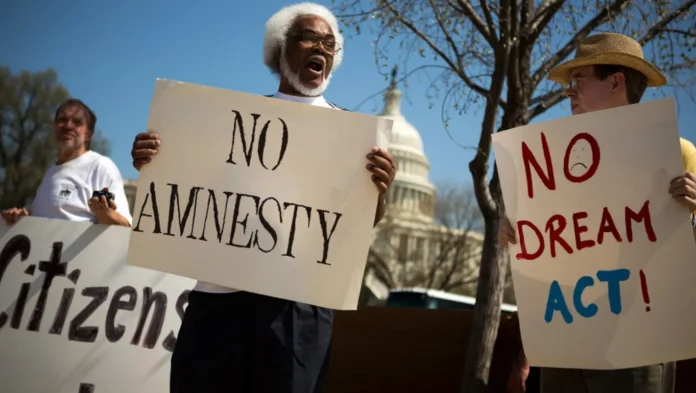
Contents
Introduction
I. Violations of the Rights of Immigrants in the United States
II. The Human Rights Violations Against Refugees and Immigrants in the United States See No Improvement
III. Multiple Domestic Factors Behind the Entrenched Immigration and Refugee Problem in the United States
IV. The United States Is the Primary Cause of the Global Refugee Crisis
Conclusion

Introduction
The United States is a nation of immigrants. Ever since colonial times, immigrants from around the world have come to the country in waves. However, the history of U.S. treatment of immigrants is one rife with inhumane tragedies such as discrimination, exclusion, arrest, detention, expulsion, and a litany of human rights abuses. Worse still, the recent years have witnessed one humanitarian disaster after another caused by the U.S. government on refugees and immigrants going to the country.
This report gives a truthful account of the United States’ egregious record on the issue of refugees and immigrants by reviewing events in the past and present within the United States and beyond. Using facts and figures, this report lays bare the lies and double standards on the issue of refugees and immigrants of the United States, a self-proclaimed “beacon of democracy.”
I. Violations of the Rights of Immigrants in the United States
◆ When the United States was first founded, white Americans, mainly Anglo-Saxon Protestants, were very suspicious of immigrants and tried to restrict and assimilate them. A U.S. president once said outright that there is no need to encourage emigration “except of useful mechanic’s-and some particular descriptions of men-or professions.” Fearful of domestic chaos inspired by the French Revolution, in 1798, the U.S. government formulated the laws such as the Naturalization Act, the Alien Act, the Alien Enemies Act and the Sedition Act. These acts made it more difficult for immigrants to become U.S. citizens and gave the president the power to imprison and deport dangerous immigrants or those from enemy countries. It is worth noting that the Alien Enemies Act is still in effect today.
◆Black people are among the earliest immigrants to the United States. Their immigration was not voluntary, but forced. After they arrived in the United States, they suffered inhuman abuses and had no human rights to speak of. In 1619, the first 20 Africans were sold as slaves to the colony of Virginia. Soon after that, the colonies passed laws to legitimate black slaves as “permanent property” whose children also automatically became slaves. The idea and the system of racism against blacks have thus taken root in America. In order to justify the enslavement of blacks, white people established an oppressive racial hierarchy based on skin color. The United States Declaration of Independence declared that “all men are created equal.” Nonetheless, the earliest U.S. Constitution did not recognize the civil rights of blacks. The three-fifths clause was introduced, under which the actual number of black slaves would be multiplied by three-fifths in the allocation of House seats. The harms of historical enslavement still haunt black descendants today. Their rights to life, development and political participation are not effectively secured.
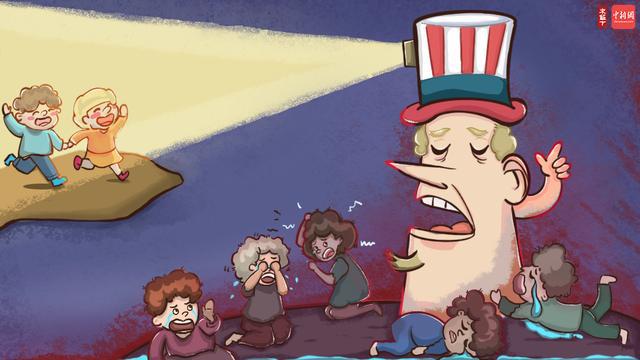
◆Irish immigrants were severely discriminated against and alienated in the early years of the United States. Between the 1830s and the 1860s, Catholic Irish immigrated to the United States in large numbers. A strong movement against Irish immigrants emerged. Irish immigrants were stigmatized and labeled as being lazy, inferior, violent and dangerous. A large number of early American nativist and exclusionist organizations and political parties were formed at this time. The American Party, or the Know-Nothing Party, made anti-Irish immigration its main agenda. In the 1850s, the party produced seven governors, eight senators and 104 House representatives. New York and Massachusetts enacted laws to deport and repatriate Irish immigrants. Xenophobes even resorted to violence, attacking Irish immigrants and burning down their churches. In 1844, riots against Irish immigrants broke out in Philadelphia, causing at least 20 deaths. Irish immigrants were treated as blacks and were not accepted by white Americans until the 20th century. They were long-time victims of racial discrimination in the United States.
◆The anti-Chinese movement is among the most infamous in discriminating and ostracizing immigrants in the U.S. history. Since the mid-19th century, Chinese laborers were trafficked in large numbers by Americans to the United States as coolies. By 1880, the total number had exceeded 100,000. The Chinese laborers undertook the most arduous work in the construction of the Central Pacific Transcontinental Railroad. Thousands of people died. They made enormous contributions to the development of the United States with their hard work and even their lives, but were not treated with respect and kindness which they deserved because of rampant racism in the United States. As the railroad projects came to completion, the United States began to turn its back on those who helped it. In 1875, the U.S. Congress passed the Page Act, obstructing the entry of Chinese laborers and women. In 1882, the United States went further and enacted the Chinese Exclusion Act, putting an absolute end to immigration from China and denying resident Chinese immigrants U.S. citizenship. It was the first and only law in the United States to ban all members of a specific ethnic group from immigrating to the country on the grounds of race and nationality. It was not until 1943 that it was formally repealed. To prevent Chinese immigration, U.S. Citizenship and Immigration Services established an immigration detention facility on San Francisco’s Angel Island in 1910, which remained open until 1940. Meanwhile, Chinese immigrants suffered from severe violent attacks. On Oct. 24, 1871, 19 Chinese immigrants were killed by hundreds of white people around Calle de los Negros in Los Angeles. In 1877, the houses of Chinese residents in Calle de los Negros were burned down by white people. In 1876 and 1877, two riots erupted in which armed white racists attacked Chinatown in San Francisco. Then on Sept.2, 1885, white miners rioted on the Stone Springs mine in Wyoming, destroying the residential village of Chinese workers and killing at least 28 Chinese immigrants.
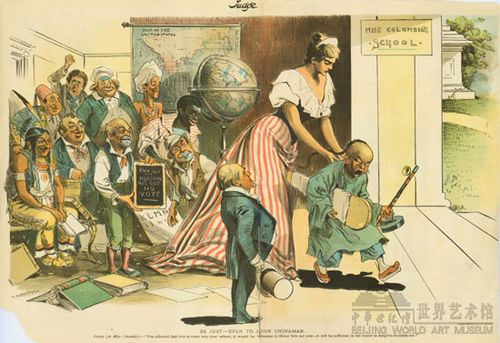
◆Japanese immigrants were discriminated against and ostracized in the United States. Although Japan had undergone Meiji Restoration and championed “leaving Asia and entering Europe” at the turn of the 20th century, Japanese immigrants still faced discrimination and exclusion in the United States because of their different skin color and distinctive culture. The U.S. West Coast saw a particularly strong anti-Japanese sentiment. San Francisco adopted a policy to ban Japanese schoolchildren from public schools. In 1907, the United States and Japan reached the so-called Gentlemen’s Agreement, meaning the United States would limit the entry of Japanese immigrants, and Japan would voluntarily ban immigration to the United States. In 1913, the California state government enacted the Alien Land Law, barring Asian immigrants, including Japanese, from owning land. In 1917, the U.S. Congress enacted the Asiatic Barred Zone Act, which barred most Asians from immigrating to the United States. After the adoption of the Immigration Act of 1924, the Japanese were completely banned from immigrating to the United States. After the attack on Pearl Harbor in 1941, 120,000 people of Japanese ancestry were forcibly moved by the U.S. government from the West Coast to internment camps further inland. They had to take “loyalty questionnaires” to completely remove their suspicion of being an enemy alien. It was not until 1988 that the U.S. government formally apologized.
◆White immigrants from Eastern and Southern Europe were strongly ostracized in the United States. Immigrants from countries like Italy, Poland, Greece and Russia made up the majority of U.S. immigrants at the turn of the 20th century. In 1911, the U.S. Congress released the Dillingham Commission report, claiming that Eastern and Southern European immigrants had made limited contributions to the United States and degraded the unique American race, culture and system. To curb their immigration, the report recommended having immigrants take literacy tests and introduced a nationality-based quota scheme. Racists sought to use the theory of evolution for their argument that immigrants from Eastern and Southern Europe belonged to an inferior non-white race, and would contaminate the race of Anglo-Saxon whites in the United States. Xenophobes launched the Americanization Movement to deprive Eastern and Southern European immigrants of their language and culture, forcing them to be fully Americanized. Henry Ford, the founder of Ford Motor Company, required migrant workers in his company to attend the so-called English Melting Pot School. White supremacist groups like the Ku Klux Klan recruited millions of members to terrorize and attack Eastern and Southern European immigrants across the country. The 1917 October Revolution in Russia triggered the first Red Scare in the United States. The U.S. government was convinced that communists were among Eastern and Southern European immigrants, and used this excuse to arrest and deport them in large numbers.
◆The fear of foreign immigrants eventually led to the adoption of a race-based quota system. Following the Chinese Exclusion Act, the U.S. government enacted a series of laws to restrict immigration, which culminated in the Immigration Act that the U.S. Congress passed in 1924. This Act stipulated that the annual number of immigrants from each country to the United States shall not exceed 2 percent of the number of foreign-born population of that nationality as recorded in the 1890 census. Since Americans was mainly made up of immigrants from Western and Northern Europe before 1890, the Act effectively banned Asian immigration and restricted immigration from Eastern and Southern Europe. Quotas for immigration from different countries were actually allocated based on skin color, race and religious beliefs. The primary goal was to ensure that the majority of Americans were Anglo-Saxon Protestants. It was not until the Immigration and Nationality Act of 1965 was passed that the restrictions based on ethnic origins were formally abolished, and that immigrants from different countries were granted a relatively equal right of entry.
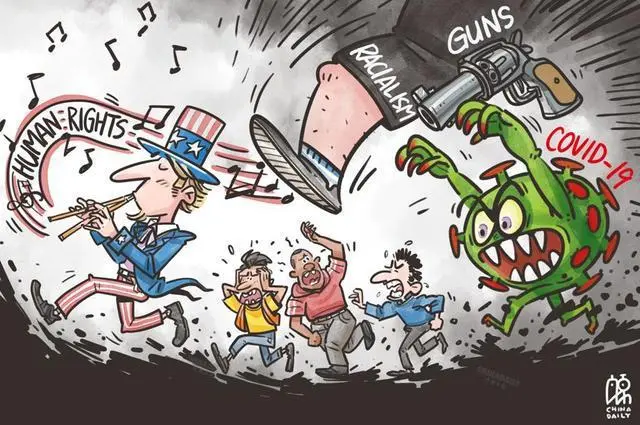
◆Hispanic immigrants, especially Mexican immigrants, have been among the most rejected by the United States since the 1920s. Most of the immigrants arrested by the U.S. Border Patrol since its establishment in 1924 have been Mexicans. In 1929, the United States made illegal entry a felony in an attempt to stop Mexican immigration. During the Great Depression, tens of thousands of Mexicans were deported from the United States. After the passing of the Immigration and Nationality Act of 1965, Mexico became the largest source of immigration to the country, with arrests and deportations of Mexican immigrants often accounting for 90 percent of the total. In the late 1970s, the number of Mexican immigrants arrested each year was close to 800,000, and then rose to 1.5 million by the late 1990s. The influx of Mexican immigrants once again stoked strong xenophobia within the United States. American political scientist Samuel Huntington points out in his book Who Are We that Mexican and Hispanic immigration “could eventually change America into a country of two languages, two cultures, and two peoples.” Hispanic immigrants are often a target of white supremacists in the United States. In 2019, angry at the ongoing “Hispanic invasion” in Texas, a white supremacist man drove more than a thousand kilometers to El Paso in West Texas and shot 23 people dead at a Walmart store. It was the largest domestic terrorist attack against Latinos in modern American history.
◆After the 9/11 incident, Muslim immigrants became a key target of U.S. surveillance and exclusion. Shortly after 9/11, more than 1,200 people, mostly Arabs and Muslims, were arrested and detained by the FBI and other law enforcement agencies. Many were held for months without charges and denied access to lawyers and family. Most ended up deported for minor immigration violations. More than 80,000 adult males from 25 Muslim countries were required by the U.S. government to be fingerprinted and photographed, among whom 13,000 migrants went into deportation proceedings and 2,870 were detained. The USA Patriot Act, enacted after 9/11, greatly expanded government powers, allowing the U.S. government to arbitrarily surveil and deport foreign nationals suspected of being involved in terrorism, and Muslims have become the main target group. The 9/11 incident had a strong impact on American society and allowed Islamophobia to penetrate deep into American politics. In 2017, the U.S. government enacted a Muslim ban, requiring that citizens of Iran, Iraq, Libya, Somalia, Sudan, Syria and Yemen be barred from entering the U.S. for at least 90 days.
II. The Human Rights Violations Against Refugees and Immigrants in the United States See No Improvement
◆In the 21st century, successive U.S. administrations have increasingly restricted immigration and treated immigrants harshly and inhumanely, with arrests, detentions, deportations and repatriation of immigrants on a large scale every year. The U.S. government arrested 850,000 migrants in 2019 and more than 1.7 million in 2021, a record high since 1986. The number of immigrants detained has grown rapidly. In August 2022, U.S. Customs and Border Protection (CBP) detained more than 203,000 illegal immigrants from Mexico. In fiscal year 2022, more than 2.3 million refugees and immigrants were arrested at the U.S.-Mexico border. A record high of more than 430,000 immigrants were deported from the United States in 2013. The number still reached 360,000 in 2019. More than 100,000 have been repatriated each year. In large-scale arrests, detentions, deportations and repatriation, the human rights of immigrants are grossly violated, and humanitarian disasters occur frequently. In September 2021, more than 15,000 refugees from Haiti gathered in the Texas border town of Del Rio, waiting for a slim chance to enter the United States. The refugees were brutalized by U.S. border enforcement agencies, with patrols on horseback wielding horse whips, charging into the crowd, and driving them into the river. The CNN commented that the scene was reminiscent of the dark periods in American history when slave patrols were used to control black slaves. On 25 October 2021, the United Nations Human Rights Council condemned the systematic and large-scale deportations by the United States of Haitian refugees and immigrants without assessing their individual situations as a violation of international law.
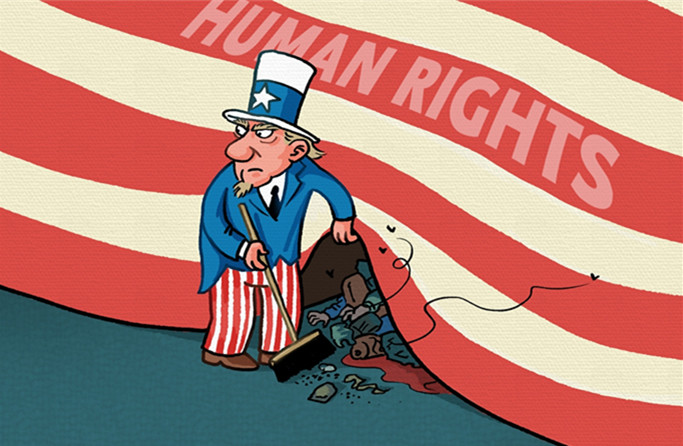
◆ The migrant truck tragedy shows how rampant human smuggling and trafficking is in the United States. On 27 June 2022, a tractor-trailer packed with illegal immigrants was found on the outskirts of San Antonio, Texas. The truck came from Laredo, a border city in Texas 150 miles away from where the vehicle was found. Local human smugglers planned to transport illegal immigrants by truck via San Antonio to the U.S. hinterland. The truck, which was abandoned on the roadside due to mechanical failure, was found with no water or air conditioning in its compartment and nearly 100 people crammed in. Among them, 53 people died from the stifling heat as local temperatures peaked at 38 degrees Celsius. It was the nation’s most serious migrant death case to date. Human trafficking and forced labor have been widespread in the United States due to long-standing ineffective law enforcement and lack of justice. Recent years have seen thousands of human smuggling and trafficking cases taking place annually and the frequent occurrences of similar migrant truck tragedies. In fiscal year 2021 alone, 557 illegal immigrants died along the southern border of the United States.
◆ After COVID-19 broke out, the U.S. government used COVID as an excuse for large-scale deportations of illegal immigrants. In 2020, the U.S. government invoked Title 42 of the United States Code to prohibit immigrants from entering under the pretext of stemming the spread of COVID. Scientists at the U.S. Centers for Disease Control and Prevention said the practice lacks a public health rationale and could instead increase the likelihood of the epidemic spreading. Through this practice, the U.S. government has made over 1.8 million deportations, expelling at least 215,000 parents and children, of whom 16,000 are unaccompanied children. The immigrants who were not deported for the time being were sent to detention facilities and continued to be subjected to inhumane treatment.
◆ The United States has set up the world’s largest immigration detention system. Currently, there are more than 200 detention facilities in its border states. In order to save costs, the U.S. government often hands construction and operation of the immigration detention camps over to private companies, making them de facto private prisons. The abysmal conditions in the camps make those detained highly susceptible to physical and psychological illness or death. In July 2019, after visiting border patrol stations on the U.S.-Mexico border, U.S. Democratic Rep. Alexandria Ocasio-Cortez said she had witnessed that the women being detained were held without drinking water and that detention officers told them to drink out of the toilet. She said that border patrol stations treat migrants like animals, constituting systemic abuse. A total of 21 people died in U.S. immigration detention facilities in fiscal year 2020, CNN reported, more than doubling the death toll in fiscal year 2019 and the highest number since 2005. Up to 80 percent of the more than 1.7 million immigrants detained in the United States in fiscal year 2021 were held in private detention facilities, including 45,000 children. The El Paso Times reported on 25 June 2021 that private contractors had exacerbated the horrible chaos at the U.S. Fort Bliss shelter where nearly 5,000 children were held. In the shelter, about 1,500 children were jailed in a stockyard-like, jam-packed and terrible environment that resulted in severe physical and mental trauma.
◆ The U.S. immigration policy has caused a serious humanitarian disaster to immigrants. To stop illegal immigrants from entering the country, the U.S. government has implemented a “zero tolerance” policy since April 2018, forcibly separating illegal immigrants from their minor children and detaining them in deplorable conditions. Footage provided by U.S. CBP shows some children even being held in cages with only thin blankets on their bodies. On 18 June 2018, at a meeting of the Human Rights Council, Zeid Ra’ad al-Hussein, the United Nations High Commissioner for Human Rights, called the practice of forcing parents to part with their children as “government-sanctioned child abuse.” UN human rights officials also called on the United States, the only country in the world that had not ratified the Convention on the Rights of the Child, to join the Convention as soon as possible and to respect the rights of all children. Hundreds of thousands of people across the 50 states of the United States staged demonstrations with the theme “Families Belong Together” to protest against the “zero tolerance” immigration policy that has resulted in the separation of at least 2,300 children from their families.
◆The U.S. law enforcement agencies have never stopped abusing migrant children. In 2019, over a thousand children were still separated from their parents, and 20 percent of them were under the age of five. After COVID-19 struck, the U.S. government enforced the provisions in Title 42 of the U.S. Code, which exacerbated the humanitarian disaster arising from the separation of children and their parents. According to a CNN report on 23 April 2021, more than 5,000 unaccompanied children were in U.S. CBP custody, and many were kept for longer than the legal limit. Records show that among the 266,000 migrant children held in government custody in recent years, more than 25,000 have been detained for longer than 100 days, nearly 1,000 for more than a year and at least three for over five years. On 26 June 2019, The New York Times covered a visit by an inspection group consisting of lawyers, doctors and journalists to a detention center of a border station in Clint, Texas. They found that children there were held in prison-like conditions. Hundreds of children were locked in one cell with virtually no adult supervision. A member of the inspection group likened the conditions to “torture facilities”. UN High Commissioner for Human Rights Michelle Bachelet was deeply shocked by the overcrowded U.S. detention facilities, the poor sanitation conditions and the lack of access to adequate healthcare or food, according to a UN website report on 8 July 2019. She stated that detaining migrant children may constitute cruel, inhuman or degrading treatment that is prohibited under international law. According to a report on the website of The Guardian on 11 October 2021, between 2016 and 2021, U.S. border agents engaged in more than 160 cases of abuse of asylum seekers, including children. Leading law enforcement agencies, notably CBP and U.S. Border Patrol, were involved.
◆Even if illegal immigrants manage to escape from detention and deportation, it is difficult for them to be treated equally in American society and they tend to become victims of crimes. The U.S. Supreme Court ruled that illegal immigrants enjoy the right to equal protection under the 14th Amendment to the U.S. Constitution. In reality, however, illegal immigrants often suffer from legal and institutional discrimination and hardly enjoy basic rights and benefits. The Illegal Immigration Reform and Immigrant Responsibility Act of 1996 abolished most forms of public relief for illegal immigrants and even banned their children born in the United States from being automatically granted citizenship and access to public benefits. Many illegal immigrants have fallen victim to human trafficking and forced labor in the United States. The Associated Press revealed on 10 December 2021 that for years, illegal immigrants smuggled into the United States ended up forced to toil on farms, cowing to threats of deportation and violence by overseers while they lived in dirty, cramped trailers with little food or clean water. Identification documents of the laborers were withheld, preventing them from leaving and seeking help. The U.S. Department of Justice website released an indictment on a human trafficking case on 22 November 2021. The document showed that dozens of workers were illegally imported from Mexico and Central America to farms in the State of Georgia. Trapped in illegal detention and forced labor in brutal conditions, the workers became victims of modern-day slavery. Promised high wages to work on farms, they were instead forced to dig onions with their bare hands, and got paid only 20 cents per filled bucket as men with guns kept them in check. At least two of them died, and another was raped repeatedly.
◆Today, the serious discrimination in American society against immigrants and their descendants remains. “Asia Hate” has been particularly prominent in recent years. According to a 2022 survey by Stop AAPI Hate, the organization had reported 11,467 hate incidents targeting Asian Americans and Pacific Islanders (AAPIs) over the past two years. Only 49 percent of AAPIs felt safe going out and 65 percent worried about the safety of family members and elders. As many as 72 percent of AAPIs who experienced hate incidents named discrimination against them as their greatest source of stress, even ahead of their health concerns during the COVID-19 pandemic.
III. Multiple Domestic Factors Behind the Entrenched Immigration and Refugee Problem in the United States
◆Deep-rooted racial discrimination in the United States is an important cause of its immigration problem. Racism is embedded in U.S. immigration policies and its attitude toward immigrants. A country founded with Anglo-Saxon Protestants as the mainstay, the United States continues to view the culture of this population group as the core of its national identity. Immigrants who are not Anglo-Saxon Protestants are often regarded as the inferior race. With the influx of Hispanic and Asian immigrants, the United States is increasingly diverse in ethnicity and culture. In recent years, immigrants accounted for 40 percent of U.S. population increase. With the white population seriously ageing, immigrants are expected to contribute even more to U.S. population growth. The demographic change has left many white people worried about their own status. Hence, they are giving stronger support to conservative political stances, regardless of their party affiliation. A poll indicated that 56 percent of American voters believed the United States remained a racist society, and 70 percent of black respondents believed that more than half of white Americans believe in white supremacy.
◆Political polarization in the United States is worsening its immigration problem. In recent decades, the immigration issue has become more entangled with economic, racial and ideological issues as well as cultural values. The Democratic Party and the Republican Party have kept attacking each other, and a compromise is hard to reach. Democrats accuse Republicans of embracing nativism and white supremacy and inciting xenophobia and racial discrimination to win votes from the white population. Republicans accuse Democrats of accepting immigrants to gain more votes from ethnic minorities and more seats in the Congress. The partisan divide has prevented any significant immigration reform bill from passing Congress since the comprehensive Immigration Reform and Control Act of 1986. Both Democrats and Republicans had put forth their own immigration reform proposals, but they all hit a dead end very soon.
◆Since the midterm election cycle began in 2022, both parties have used the refugee and immigrant issue as a political leverage. The administration pandered to voters and relaxed immigration control to some extent. With the “American Dream” rekindled, illegal immigrants flooded in across the borders. Some Republican governors transported refugees and illegal immigrants with buses and chartered planes from theirs to blue states and cities in an attempt to embarrass the federal government. In September 2022, Florida’s Republican Governor flew 50 refugees from Texas to Martha’s Vineyard, Massachusetts. Republican Governor of Texas bused over 100 Latin American refugees and immigrants right to the Vice President’s doorstep. These immigrants were promised well-paid jobs before being transferred, only to find that still no proper settlement is available at their destination.
◆Conservative politicians and media in the United States are hyping up the immigrant threat and stoking anti-immigration sentiment. The far-right forces and conservative media have been disseminating a so-called “great replacement” theory, claiming that white Americans are being deliberately replaced by immigrants and ethnic minorities. This extreme idea has led to multiple terrorist attacks targeting immigrants and ethnic minorities in the country, the worst of which is the shooting incident in a shopping mall in El Paso. Since 2018, white supremacists have committed the most killings among violent extremist groups in the United States. In recent years, the Republicans have been playing up the immigrant threat in election campaigns, and drawn the attention from the conservatives to the immigration issue. They have rolled out many extreme anti-immigration measures, grossly violating the human rights of immigrants. For its part, the Democratic administration dare not to relax expulsion or detention of immigrants in fear of conservative opposition and in order to gain support from white voters, resulting in massive humanitarian disasters continuing in the United States. U.S. conservative politicians and media have also been depicting immigrants as grabbing jobs from low-skilled American workers, lowering wages, squeezing welfare resources, and increasing local government expenditure on education, healthcare and relief. They scapegoat immigrants for U.S. domestic problems, yet ignore their long-term, generally positive effect on the U.S. economy, such as supplying a large workforce, filling up low-level jobs that Americans won’t take, and mitigating the impact of population ageing.
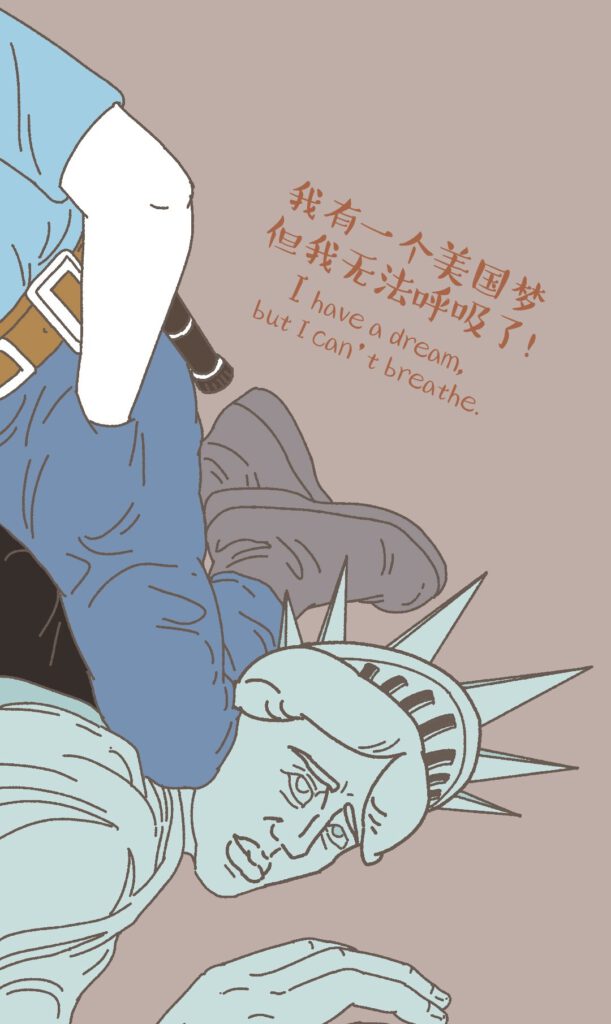
V. The United States Is the Primary Cause of the Global Refugee Crisis
◆ The United States follows hegemonic and militaristic policies. Throughout the country’s more than 240 years of history, only 16 years were without wars. Former U.S. President Jimmy Carter candidly referred to the United States as “the most warlike nation in the history of the world.” The country’s aggressive behaviors have led to waves of refugees. Since 2001, U.S. invasions have resulted in over 800,000 deaths and 20 million refugees in Afghanistan, Iraq, Syria and other affected countries. According to a Brown University project entitled “the Costs of War,” military operations launched by the United States in 85 countries in the name of “fighting terrorism” since 2001 have costed 6.4 trillion U.S. dollars and claimed more than 929,000 lives. Up to 38 million people were displaced in the fightings.
◆In Asia, U.S. involvement in the Korean War resulted in over three million civilian deaths and around three million refugees. The trauma of war persists to this day. Many Korean families were divided because of the long-standing confrontation on the Peninsula. Official data from the ROK alone indicate that the number of people registered as divided family members exceeds 132,000. Many senior citizens worry that to reunite with their families in the DPRK would be too distant a dream in their lifetime. In the 1970s, after losing the Vietnam War, the United States withdrew hastily from Saigon, displacing innumerable refugees out of the country.
◆In the Middle East, the United States launched the Iraq War based on fabricated evidence in 2003, in the absence of authorization of the UN Security Council and despite strong opposition from the international community. According to Statista, a global database, around 209,000 Iraqi civilians died in the war and ensuing violent conflicts between 2003 and 2021, and around 9.2 million Iraqis became refugees or were forced to leave their homeland. The United States involved itself deeply in the Syrian war and the internal conflict in Libya through multiple proxies, causing prolonged conflicts and leaving political settlement and social stability elusive. According to UN statistics, U.S. military intervention in Syria has left at least 350,000 people dead, 12 million displaced and 14 million in urgent need of humanitarian assistance. The UN refers to the Syrian refugee problem as “the biggest humanitarian and refugee crisis of our time”. According to estimates of the UN High Commissioner for Refugees (UNHCR), the war in Afghanistan, which lingered for more than two decades, has forced 2.6 million Afghans to flee the country and displaced 3.5 million.
◆In Europe, U.S. intervention in the Federal Republic of Yugoslavia in the 1990s escalated ethnic tensions in the country. The wars in Bosnia and Herzegovina and Kosovo resulted in nearly 300,000 deaths and nearly three million refugees. In March 1999, NATO forces led by the United States blatantly bypassed the UN Security Council to carry out a 78-day bombing of Yugoslavia under the pretext of “averting humanitarian disaster”, causing over 2,000 civilian deaths, over 6,000 injuries and around a million displaced people.
◆U.S. military interventions around the world triggered a refugee crisis in Europe. It is widely held in Europe that U.S. interference and military operations in such countries as Afghanistan, Iraq, and Syria gave rise to waves of refugees, but it is Europe, not the United States, that received them. Most of the affected people fled to Europe in the wake of the Syrian refugee crisis, exacerbating anti-immigrant sentiments and right-wing populist movements in Europe. By contrast, the Republican administration in the United States was tough on taking Syrian refugees, bringing refugee admission to a 40-year low and categorically banning refugees from seven Islamic countries from entering the country. The Democratic administration urged the EU to admit some Afghan refugees, a move upsetting the EU which feared that another surge of Muslim refugees could again heighten the right-wing populist movements. French President Emmanuel Macron put it bluntly that Europe alone will not be able to assume the consequences of the current situation in Afghanistan.
◆In Latin America, long-time U.S. intervention in internal affairs led to instability and economic backwardness in the region. As a result, a large number of refugees and immigrants were forced to seek asylum and livelihood in the United States. To check the flow of immigration from Latin America, the United States forcefully expelled and repatriated refugees and immigrants, and made those attempting to leave stay in their country of origin. The United States’ vehement expulsion and repatriation of Latino immigrants exacerbated instability, violent crime and humanitarian crisis in the region. “The United States spent decades contributing to regime change and destabilization in Latin America,” criticized Alexandria Ocasio-Cortez, a Democratic member of the U.S. House of Representatives, “We can’t help set someone’s house on fire and then blame them for fleeing.”
◆The United States and Latin American countries are at loggerheads over immigration and border issues. After being expelled from the United States, refugees and immigrants often become stranded in Mexico, posing a challenge to the country’s ability to host and accommodate them and causing public security concerns for the Mexican government. While the United States keeps urging Mexico to do more to prevent its refugees and immigrants and those of other Central American countries from coming to the United States, Mexico blames the surge of refugees and immigrants on the U.S. immigration policy. In recent years, the Northern Triangle of Central America, i.e. Guatemala, El Salvador, and Honduras became the top source of refugees and immigrants to the United States. The U.S. government pressed the governments of the three countries and issued stern warnings to potential immigrants. Its tough stance sparked frustration in Central America and triggered backlash domestically.
◆The eastward expansion of NATO led by the United States is an important root cause of the Ukraine crisis. Being the initiator and biggest driver of the crisis, the United States cannot shirk off its responsibility for the sufferings of Ukrainian refugees. After the conflict between Russia and Ukraine started, however, the U.S. government suggested that Ukrainian refugees should stay in European countries or return to Ukraine as soon as possible, and was reluctant to take them in on a large scale. As of January 2023, UNHCR data indicated that more than 7.91 million Ukrainian refugees were registered across Europe. It was not until the end of July 2022 that the U.S. government claimed to have received 100,000 Ukrainian refugees, a number significantly dwarfed by Europe Union, and the real purpose of the U.S. move was actually for Ukrainian Americans to reunite with their families.
Conclusion
A review of U.S. history would expose the country’s cruel treatment of immigrants from almost all around the world, including people of African, Irish, Eastern European, Southern European, Jewish, Asian, Latino, and Muslim origins. The U.S. government interferes in the domestic affairs of other countries and launches wars across the world, creating large-scale humanitarian disasters and immigration crises while refusing to take responsibility and shifting the blame onto others. The United States needs to seriously reflect on its terrible record on the issue of refugees and immigrants and correct its course, and make real efforts to improve the situations of foreign refugees and immigrants in the country. It should stop all hegemonic and bullying practices, stop creating new crises, stop acting like a “human rights guardian”, and stop using human rights as a pretext to smear and attack others.
(Quelle: U.S. Human Rights Abuse Against Refugees and Immigrants: Truth and Facts (fmprc.gov.cn))



